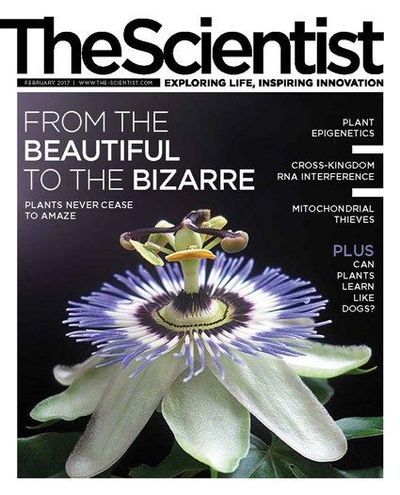Login
SubscribeFeatures

Plants’ Epigenetic Secrets
Jef Akst | Feb 1, 2017 | 10+ min read
Unlike animals, plants stably pass on their DNA methylomes from one generation to the next. The resulting gene silencing likely hides an abundance of phenotypic variation.

RNA Interference Between Kingdoms
Kerry Grens | Feb 1, 2017 | 10+ min read
Plants and fungi can use conserved RNA interference machinery to regulate each other’s gene expression—and scientists think they can make use of this phenomenon to create a new generation of pesticides.

May the Force Be with You
Ning Wang | Feb 1, 2017 | 10 min read
The dissection of how cells sense and propagate physical forces is leading to exciting new tools and discoveries in mechanobiology and mechanomedicine.
Contributors
Contributors
Contributors
Meet some of the people featured in the February 2017 issue of The Scientist.
Editorial
A Walk on the Wild Side
A Walk on the Wild Side
Plants have so much to teach us.
Speaking of Science
Notable Science Quotes
Notable Science Quotes
Intellectual property theft, gun violence, scientific failure, and more
Notebook
This Parasitic Plant Steals More Than Nutrients From Its Hosts
This Parasitic Plant Steals More Than Nutrients From Its Hosts
The plant Lophophytum pilfers mitochondrial genes from the species it parasitizes.
Can Plants Learn to Associate Stimuli with Reward?
Can Plants Learn to Associate Stimuli with Reward?
A group of pea plants has displayed a sensitivity to environmental cues that resembles associative learning in animals.
Pitcher Plant Enzymes Digest Gluten in Mouse Model
Pitcher Plant Enzymes Digest Gluten in Mouse Model
A newly discovered protease could break down grain proteins that trigger celiac disease.
Abscisic Acid’s Role in Ferns Finally Determined
Abscisic Acid’s Role in Ferns Finally Determined
Researchers solve the mystery of 15-year-old mutant ferns with disrupted sex determination.
Critic at Large
Opinion: An Ethical Code for Conferences
Opinion: An Ethical Code for Conferences
This fundamental form of scientific communication is threatened by modern recording technology and researchers who refuse to adhere to an age-old ethical code.
Modus Operandi
Deep Pocket Exploration
Deep Pocket Exploration
A modification to traditional docking software enables the examination of a ligand’s passage into its receptor.
The Literature
Plant Photoreceptor Doubles as a Thermometer
Plant Photoreceptor Doubles as a Thermometer
Warmth acts on a light-sensing protein similarly to the way shade does, setting off a growth spurt in plant seedlings.
The Fungus that Poses as a Flower
The Fungus that Poses as a Flower
Mummy berry disease coats blueberry leaves with sweet, sticky stains that smell like flowers, luring in passing insects to spread fungal spores.
Profile
From the Ground Up
From the Ground Up
Instrumental in launching Arabidopsis thaliana as a model system, Elliot Meyerowitz has since driven the use of computational modeling to study developmental biology.
Scientist to Watch
Andrea Eveland Teases Apart Gene Networks in Crop Plants
Andrea Eveland Teases Apart Gene Networks in Crop Plants
The Donald Danforth Plant Science Center researcher links complex traits to the genes that underlie them.
Lab Tools
Discovering Novel Antibiotics
Discovering Novel Antibiotics
Three methods identify and activate silent bacterial gene clusters to uncover new drugs
Bio Business
Pharma Cooperates to Achieve Precision Medicine
Pharma Cooperates to Achieve Precision Medicine
The challenges of adapting drug development to the age of personalized therapies encourage collaboration among industry players.
Reading Frames
Cannibalism: Not That Weird
Cannibalism: Not That Weird
Eating members of your own species might turn the stomach of the average human, but some animal species make a habit of dining on their own.
Foundations
19th Century Experiments Explained How Trees Lift Water
19th Century Experiments Explained How Trees Lift Water
A maple branch and shattered equipment led to the cohesion-tension theory, the counterintuitive claim that water’s movement against gravity involves no action by trees.

















